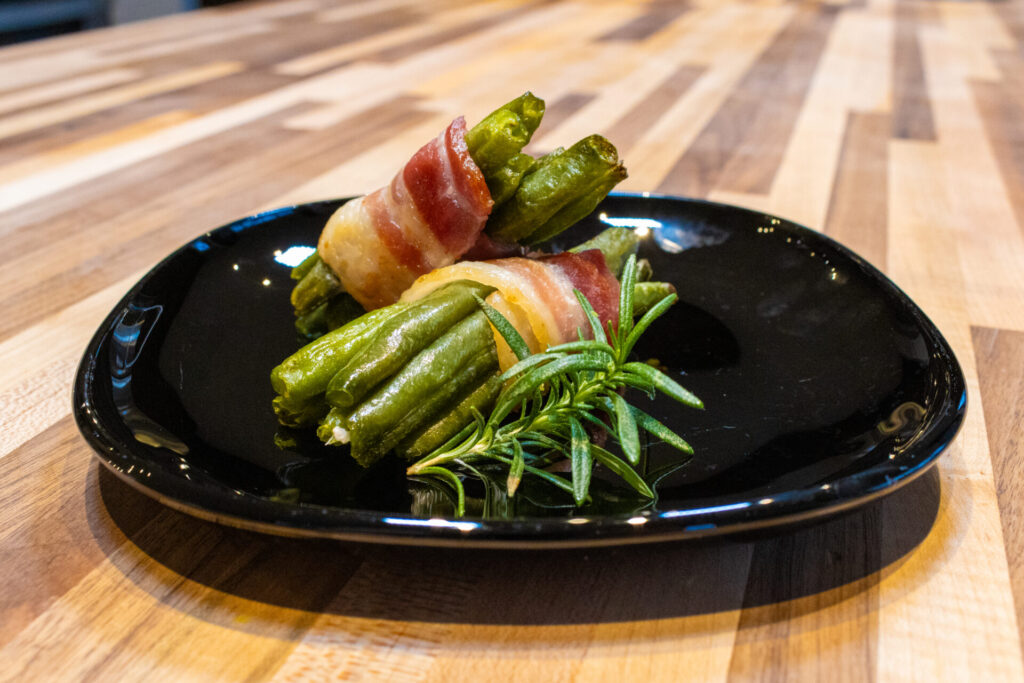In the grand tapestry of culinary creations, where flavors intertwine and textures dance, there exists a dish that embodies the very essence of simplicity and satisfaction: Bacon-Wrapped Beans. This seemingly humble creation, a testament to the transformative power of culinary ingenuity, elevates the ordinary green bean to extraordinary heights, creating a symphony of flavors and textures that is as captivating as it is delicious.
Imagine, if you will, a culinary stage where vibrant green beans, glistening with anticipation, take center stage. These slender stalks, plucked from the fertile embrace of the earth or liberated from their icy slumber, are about to embark on a culinary adventure of epic proportions. Their destiny? To be swaddled in the smoky embrace of bacon, their savory partner in this gastronomic ballet.
As these bacon-clad bundles of joy bask in the warmth of the oven, a transformation of epic proportions unfolds. The kitchen, once a haven of quiet anticipation, now reverberates with the sizzle and pop of rendering bacon, its smoky aroma a siren song that beckons all who enter to partake in this culinary spectacle.
Bacon-Wrapped Beans is not merely a dish; it’s a culinary chameleon, effortlessly adapting to any occasion and captivating all who encounter its irresistible charm. Whether gracing the table as a sophisticated side dish, its vibrant green hues complementing a perfectly seared steak, or taking center stage as a show-stopping appetizer, these bacon-wrapped bundles of joy are guaranteed to elicit gasps of delight and sighs of contentment.
Act I: The Green Bean’s Grand Entrance
Our culinary odyssey commences with the careful selection of our verdant protagonists: the green beans. Whether fresh from the farmer’s market, their delicate stems still damp with morning dew, or liberated from their frozen slumber, these emerald gems hold the promise of a delightful crunch and a subtle sweetness that perfectly complements the smoky bacon.
If we’re fortunate enough to have fresh beans at our disposal, we begin by paying homage to their natural beauty. Gently rinsing them under a stream of cool water, we remove any lingering traces of the earth from which they sprung. A quick trim of their delicate ends ensures that only the most tender and flavorful portions embark on this culinary adventure.
Next, we introduce our green bean protagonists to a steaming bath, a brief but essential encounter that sets the stage for their transformation. This blanching process, a mere dip in boiling water, ensures that the beans retain their vibrant green hue while developing a tender-crisp texture, a perfect counterpoint to the smoky bacon that awaits them.
Frozen beans, often pre-cooked and eager to join the culinary festivities, require only a brief immersion in boiling water to thaw and awaken their inherent flavors. This gentle reawakening ensures they’re perfectly primed for their bacon embrace.
Act II: A Prelude of Sizzling Sensations
While this step is optional, it adds a depth of flavor that elevates our Bacon-Wrapped Beans to an entirely new realm of culinary delight. A skillet, heated to a fiery intensity, becomes the stage for our green beans to showcase their versatility. As they sizzle and dance in a glistening pool of oil, their vibrant green hue deepens, their surfaces kissed by a touch of caramelization that hints at the symphony of flavors to come.
A sprinkle of salt and pepper, like a conductor’s baton, guides their transformation, enhancing their natural sweetness and adding a subtle savory note that harmonizes perfectly with the impending bacon embrace.
Act III: The Bacon and Bean Ballet
Now, for the moment that has been eagerly anticipated: the grand pas de deux of bacon and beans. With a delicate touch, we gather our blanched and sautéed green beans, their vibrant green hues a stark contrast to the rosy bacon slices that await them. Each bean, like a graceful dancer, is carefully wrapped in a thin slice of bacon, its savory embrace promising a flavor explosion with every bite.
These miniature bundles of joy, carefully arranged on a baking sheet lined with parchment paper, resemble a culinary chorus line, ready to take their place in the grand finale.
Act IV: The Oven’s Warm Embrace
With our oven preheated to a balmy 350°F, we usher our baking sheet of Bacon-Wrapped Beans into its warm embrace. As the heat works its magic, the bacon begins to render its fat, its smoky essence permeating the air and infusing the beans with its savory kiss. The beans, in turn, soften slightly, their natural sweetness mingling with the smoky bacon to create a harmonious blend of flavors that dances on the palate.
The beauty of Bacon-Wrapped Beans lies in its adaptability. The oven becomes our culinary playground, allowing us to customize the cooking time to achieve our desired level of bacon doneness. Whether you prefer your bacon crisp and crackling, like a standing ovation, or slightly chewy with a hint of give, the final act is entirely yours to orchestrate.
The Grand Finale: A Culinary Masterpiece Unveiled
As the intoxicating aroma of smoky bacon and tender green beans reaches its crescendo, we carefully retrieve our baking sheet from the oven. The Bacon-Wrapped Beans emerge glistening, their bacon blankets golden brown and irresistibly crisp.
Whether taking their place as a supporting cast member alongside a juicy steak or commanding the spotlight as a standalone appetizer, Bacon-Wrapped Beans are guaranteed to steal the show. Their elegant presentation and irresistible flavors make them a welcome addition to any table, a culinary symphony that harmonizes simplicity and sophistication.
So, gather your ingredients, embrace your inner chef, and embark on this epic culinary adventure. With a touch of creativity and a love for good food, you’ll create a dish that’s as delightful to prepare as it is to devour. Bacon-Wrapped Beans, a culinary masterpiece in its simplicity, awaits your command.
Read less






Share
Click on the icons below to share "Title of the item to share"